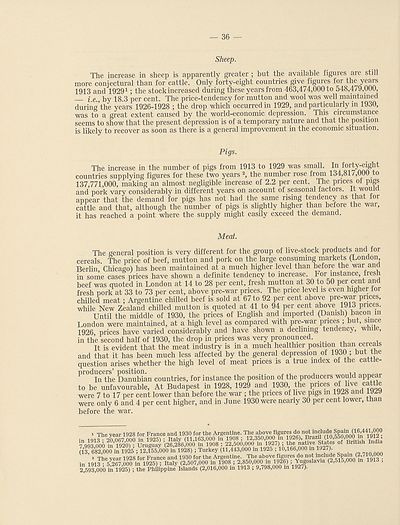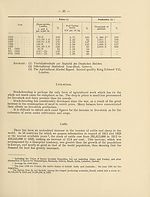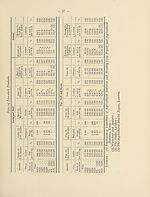Download files
Complete book:
Individual page:
Thumbnail gallery: Grid view | List view

— 36 —
Sheep.
The increase in sheep is apparently greater ; but the available figures are still
more conjectural than for cattle. Only forty-eight countries give figures for the years
1913 and 19291; the stock increased during these years from 463,474,000 to 548,479,000,
ix., by 18.3 per cent. The price-tendency for mutton and wool was well maintained
during the years 1926-1928 ; the drop which occurred in 1929, and particularly in 1930,
was to a great extent caused by the world-economic depression. This circumstance
seems to show that the present depression is of a temporary nature and that the position
is likely to recover as soon as there is a general improvement in the economic situation.
Pigs.
The increase in the number of pigs from 1913 to 1929 was small. forty-eight
countries supplying figures for these two years 2 * *, the number rose from 134,817,000 to
137,771,000, making an almost negligible increase of 2.2 per cent. The prices of pigs
and pork vary considerably in different years on account of seasonal factors. It would
appear that the demand for pigs has not had the same rising tendency as that for
cattle and that, although the number of pigs is slightly higher than before the war,
it has reached a point where the supply might easily exceed the demand.
Meat.
The general position is very different for the group of live-stock products and for
cereals. The price of beef, mutton and pork on the large consuming markets (London
Berlin, Chicago) has been maintained at a much higher level than before the war and
in some cases prices have shown a definite tendency to increase. For instance, fresh
beef was quoted in London at 14 to 28 per cent, fresh mutton at 30 to 50 per cent and
fresh pork at 33 to 73 per cent, above pre-war prices. The price level is even higher ior
chilled meat; Argentine chilled beef is sold at 67 to 92 per cent above pre-war prices,
while New Zealand chilled mutton is quoted at 41 to 94 per cent above 1913 prices.
Until the middle of 1930, the prices of English and imported (Danish) bacon in
London were maintained, at a high level as compared with pre-war prices ; but, since
1926 prices have varied considerably and have shown a declining tendency, while,
in the second half of 1930, the drop in prices was very pronounced.
It is evident that the meat industry is in a much healthier position than cereals
and that it has been much less affected by the general depression of 1930; but the
question arises whether the high level of meat prices is a true index of e ca e
P In the Danubian countries, for instance the position of the producers would appear
to be unfavourable, At Budapest in 1928, 1929 and 1930 the prices of live cattle
were 7 to 17 per cent lower than before the war ; the prices of live pigs in 1928 and 192y
were only 6 and 4 per cent higher, and in June 1930 were nearly 30 per cent lower, than
before the war.
1 The year 1928 for France and 1930 for the Argentine. The above figures do not include ^Pain (16,441,000
in 1913 • 20 067 000 in 1925) ; Italy (11,163,000 in 1908 ; 12,350,000 in 1926), Brazil (10,550,000 in 1912 ,
7 993 000 in 1920) • Uruguay (26,286,000 in 1908 ; 22,500,000 in 1927) ; the native States of British India
(13^ 682,000 in 19255; 1^2455^000 in 1928) ; Turkey (11,443,000 in 1925 ; 10,166,000 m 1927).
2 The vear 1928 for France and 1930 for the Argentine. The above figures do not mclude Spain (2,710,000
in 1913 ;e5!2e6a7r,J0208inOri92r5a) ; Italy (2,507,000 in 1%08 ; ^,000 in 1926) ; Yugoslavia (2,515,000 m 1913 ,
2,593,000 in 1925) ; the Philippine Islands (2,016,000 in 1913,9,798,000 in 1927).
Sheep.
The increase in sheep is apparently greater ; but the available figures are still
more conjectural than for cattle. Only forty-eight countries give figures for the years
1913 and 19291; the stock increased during these years from 463,474,000 to 548,479,000,
ix., by 18.3 per cent. The price-tendency for mutton and wool was well maintained
during the years 1926-1928 ; the drop which occurred in 1929, and particularly in 1930,
was to a great extent caused by the world-economic depression. This circumstance
seems to show that the present depression is of a temporary nature and that the position
is likely to recover as soon as there is a general improvement in the economic situation.
Pigs.
The increase in the number of pigs from 1913 to 1929 was small. forty-eight
countries supplying figures for these two years 2 * *, the number rose from 134,817,000 to
137,771,000, making an almost negligible increase of 2.2 per cent. The prices of pigs
and pork vary considerably in different years on account of seasonal factors. It would
appear that the demand for pigs has not had the same rising tendency as that for
cattle and that, although the number of pigs is slightly higher than before the war,
it has reached a point where the supply might easily exceed the demand.
Meat.
The general position is very different for the group of live-stock products and for
cereals. The price of beef, mutton and pork on the large consuming markets (London
Berlin, Chicago) has been maintained at a much higher level than before the war and
in some cases prices have shown a definite tendency to increase. For instance, fresh
beef was quoted in London at 14 to 28 per cent, fresh mutton at 30 to 50 per cent and
fresh pork at 33 to 73 per cent, above pre-war prices. The price level is even higher ior
chilled meat; Argentine chilled beef is sold at 67 to 92 per cent above pre-war prices,
while New Zealand chilled mutton is quoted at 41 to 94 per cent above 1913 prices.
Until the middle of 1930, the prices of English and imported (Danish) bacon in
London were maintained, at a high level as compared with pre-war prices ; but, since
1926 prices have varied considerably and have shown a declining tendency, while,
in the second half of 1930, the drop in prices was very pronounced.
It is evident that the meat industry is in a much healthier position than cereals
and that it has been much less affected by the general depression of 1930; but the
question arises whether the high level of meat prices is a true index of e ca e
P In the Danubian countries, for instance the position of the producers would appear
to be unfavourable, At Budapest in 1928, 1929 and 1930 the prices of live cattle
were 7 to 17 per cent lower than before the war ; the prices of live pigs in 1928 and 192y
were only 6 and 4 per cent higher, and in June 1930 were nearly 30 per cent lower, than
before the war.
1 The year 1928 for France and 1930 for the Argentine. The above figures do not include ^Pain (16,441,000
in 1913 • 20 067 000 in 1925) ; Italy (11,163,000 in 1908 ; 12,350,000 in 1926), Brazil (10,550,000 in 1912 ,
7 993 000 in 1920) • Uruguay (26,286,000 in 1908 ; 22,500,000 in 1927) ; the native States of British India
(13^ 682,000 in 19255; 1^2455^000 in 1928) ; Turkey (11,443,000 in 1925 ; 10,166,000 m 1927).
2 The vear 1928 for France and 1930 for the Argentine. The above figures do not mclude Spain (2,710,000
in 1913 ;e5!2e6a7r,J0208inOri92r5a) ; Italy (2,507,000 in 1%08 ; ^,000 in 1926) ; Yugoslavia (2,515,000 m 1913 ,
2,593,000 in 1925) ; the Philippine Islands (2,016,000 in 1913,9,798,000 in 1927).
Set display mode to:
![]() Universal Viewer |
Universal Viewer | ![]() Mirador |
Large image | Transcription
Mirador |
Large image | Transcription
Images and transcriptions on this page, including medium image downloads, may be used under the Creative Commons Attribution 4.0 International Licence unless otherwise stated. ![]()
| League of Nations > Economic and financial section > Agricultural crisis > Volume 1 > (38) |
|---|
| Permanent URL | https://digital.nls.uk/190903144 |
|---|
| Shelfmark | LN.II.2/2.(35) |
|---|---|
| Attribution and copyright: |
|
| Shelfmark | LN.II.2/2.(35-35) |
|---|---|
| Shelfmark | LN.II |
|---|
| Description | Over 1,200 documents from the non-political organs of the League of Nations that dealt with health, disarmament, economic and financial matters for the duration of the League (1919-1945). Also online are statistical bulletins, essential facts, and an overview of the League by the first Secretary General, Sir Eric Drummond. These items are part of the Official Publications collection at the National Library of Scotland. |
|---|---|
| Additional NLS resources: |
|

